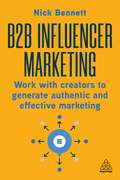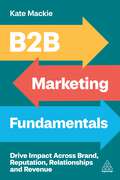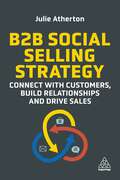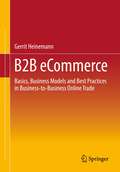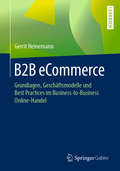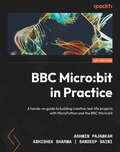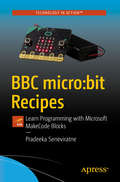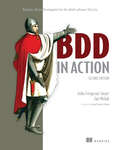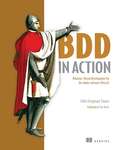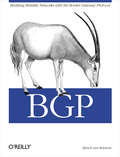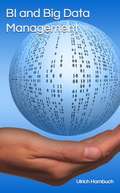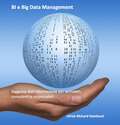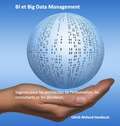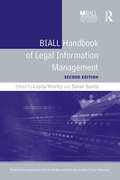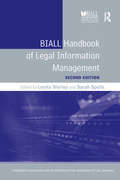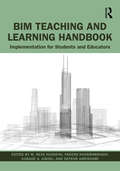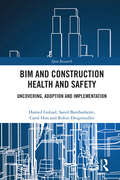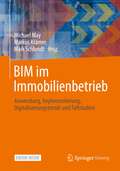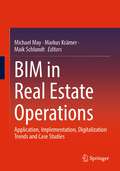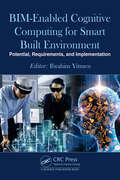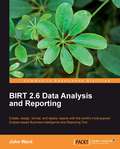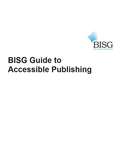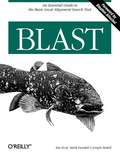- Table View
- List View
B2B Influencer Marketing: Work With Creators to Generate Authentic and Effective Marketing
by Nick BennettHave you ever wondered how your B2B brand could use influencers to drive revenue? Ever seen B2C brands killing it in the creator economy and wanted to do the same? If so, this practical guide on how B2B brands can partner with creators to generate more authentic and effective campaigns is the book for you.Transform your B2B marketing strategy with the power of influencer marketing. B2B Influencer Marketing is a comprehensive guide for B2B brands looking to leverage the creator economy to drive revenue and enhance campaign effectiveness. This book demystifies influencer marketing for B2B businesses, offering actionable insights and strategies to build successful influencer partnerships.Explore the history and evolution of influencer marketing, understand the landscape and learn how to forge long-term partnerships with creators. From choosing the right influencers to measuring campaign performance, this guide provides a road map to navigate the complexities of influencer marketing. With practical advice and real-world examples from companies including Dell and Spotify, this book is an essential resource for any B2B marketer looking to harness the power of influencer marketing.
B2B Marketing Fundamentals: Drive Impact Across Brand, Reputation, Relationships and Revenue
by Kate MackieThis practical guide is the ultimate marketing fundamentals book for B2B marketers. Taking well-proven marketing theories and frameworks and applying them to the very specific B2B marketplace, this book delivers a one-stop guide for early to mid-career marketers looking to develop their understanding of how B2B marketing works.There has never been a better time to be a B2B marketer, but navigating its complexities can pose challenges. This guide helps break down the complex world of B2B marketing for the next generation to develop the knowledge and skills they need to deliver strong B2B marketing strategies. Including content on how the use of AI and connected data can drive actional insight, this book gives you a thorough understanding of everything you need to know in B2B. With real-world examples from companies such as Barclays, Mishcon de Raya and The Marketing Society, this guide explores not only of how to deliver results across brand, reputation, relationships and revenue, but also how you can communicate your plans, initiatives, results and ultimately revenue impact in a way that can be understood across the business.
B2B Social Selling Strategy: Connect with Customers, Build Relationships and Drive Sales
by Julie AthertonSocial media, when deployed strategically and effectively in B2B channels, offers a uniquely personal long-term networking opportunity for sales teams and business professionals. For many, this has supercharged their sales performance, with empowered teams, faster results, and higher revenues. For others, the challenges of navigating social channels for business can be daunting. Concerns over social media confidence, personal and professional conflicts of interest, and a loss of management control can lead to a lack of action or ineffective modes of engagement.B2B Social Selling Strategy provides a clear framework for identifying the right social channels, connecting with potential and existing customers and measuring success against objectives and KPIs.Featuring original research, case studies and interviews with industry professionals, the book also shows how to generate content to attract attention and gain trust, work with B2B influencers and create a social selling culture. Exploring how to build your personal brand in synergy with your business and integrate social selling with other sales and marketing channels, it is supported by online interactive tools and templates to be used to create and execute your own social selling strategy. Written by a recognized social media expert, B2B Social Selling Strategy is an indispensable guide for B2B sales, marketing and social media professionals.
B2B eCommerce: Basics, Business Models and Best Practices in Business-to-Business Online Trade
by Gerrit HeinemannThis textbook covers the basics of business-to-business (B2B) eCommerce, where similar principles of customer targeting can be observed as in B2C eCommerce. Gerrit Heinemann highlights the specifics and business models of B2B eCommerce, analyzes the digital challenges and shows the consequences and opportunities for online sales in B2B. Recognised best-practice examples illustrate how successful B2B eCommerce can work and which risks have to be considered.
B2B eCommerce: Grundlagen, Geschäftsmodelle und Best Practices im Business-to-Business Online-Handel
by Gerrit HeinemannDieses Lehrbuch behandelt die Grundlagen des eCommerce im Bereich Business-to-Business (B2B), bei dem ähnliche Prinzipien der Kundenansprache zu beobachten sind wie im B2C eCommerce. Gerrit Heinemann beleuchtet die Besonderheiten und Geschäftsmodelle des B2B eCommerce, analysiert die digitalen Herausforderungen und zeigt die Konsequenzen und Chancen für den Online-Verkauf im B2B auf. Anerkannte Best-Practice-Beispiele veranschaulichen, wie erfolgreicher B2B eCommerce funktionieren kann und welche Risiken dabei zu beachten sind.
BBC Micro: A hands-on guide to building creative real-life projects with MicroPython and the BBC Micro:bit
by Ashwin Pajankar Sandeep Saini Abhishek SharmaDevelop real-world interactive physical computing applications using the Micro:bit with more than 100 MicroPython examples with circuit diagramsKey FeaturesExplore hardware programming and leverage the power of the BBC Micro:bit and MicroPythonBuild real-life creative projects step by step with each chapter increasing in complexity and interactivityLearn the features of the Micro:bit and how to interface it with electronic components through circuits and code examplesBook DescriptionThis book is a one-stop guide for learning BBC Micro:bit with MicroPython, exploring many hardware components and programming techniques to provide detailed insights into developing practical applications with the Micro:bit. It will also show you how hardware components can be manipulated using a combination of Micro:bit and MicroPython for developing practical projects. BBC Micro:bit in Practice will help you gain a holistic understanding of the BBC Micro:bit platform and MicroPython programming, guiding you through mini projects aimed at developing practical knowledge of circuit design and writing programs. You'll learn how to write programs for working with built-in LEDs and buttons, interfacing external LEDs, buttons, motors, buzzers, and much more. You'll also work with built-in radio, speakers, accelerometer, and a compass. You'll dive into concepts related to the Micro:bit filesystem, interfacing external displays, and working with libraries in detail before exploring sewable circuits and wearable technology.After reading this Micro:bit book, you'll understand how to apply principles in electronics and MicroPython to create interesting real-life projects from scratch.What you will learnExplore the essentials of the BBC Micro:bit, its hardware specifications, and versionsProgram built-in and external LEDs and buttonsProgram external LED-based displays, buzzers, and stepper motorsUse analog input and pulse width modulation to drive a servo motorDetect gestures with internal sensors such as accelerometer, compass, and magnetometerWork on projects with built-in features such as music, speech, radio, and filesystemExplore the advanced features of the Micro:bitWho this book is forThis book is for anyone who wants to use the combination of MicroPython and the BBC Micro:bit for building exciting real-life projects. Engineers, researchers, hobbyists, and technology instructors working in areas such as embedded systems, electronics, software development, IoT, robotics, teaching, and training will find this book useful for building projects. Prior experience with building basic electronic circuits and any programming language, not necessarily MicroPython, will be helpful.
BBC micro: Learn Programming with Microsoft MakeCode Blocks
by Pradeeka SeneviratneBuild engaging programs for the BBC micro:bit using Microsoft's MakeCode web editor. Using this open source platform, you'll learn to program in an accessible way that easily translates into real-world programming. BBC micro:bit Recipes is a practical guide with a problem-solving approach. It provides exact solutions for common application development problems for the micro:bit using MakeCode. You'll discover and apply techniques that can be used to build simple games with sprites, keep score, and control game play.The micro:bit is a small programmable device that is a cross between a very small computer and a programmable embedded board. It is easy to program, extremely versatile, and designed with young learners in mind. In particular, it is designed to be easy for people who have never programmed before.By the end of this book, you'll have the foundation to build programs with the Microsoft MakeCode editor and use and process data with built-in sensors, such as accelerometer, compass, temperature, touch, and light. You'll also see how to work with communication protocols, such as Serial, I2C, and SPI and how to use variables, loops, logic, arrays, math and functions to easily solve problems. What You'll LearnDisplay text, images, and animations on the micro:bit displayConnect external sensors and process dataMake and play music through speakers and headphonesUse Bluetooth service to communicate with Smartphones and tabletsWho This Book Is ForThose who are interested in learning to program the BBC micro:bit with Microsoft MakeCode. The difficulty level falls from beginner to intermediate level.
BDD in Action, Second Edition: Behavior-Driven Development for the whole software lifecycle
by John Ferguson Smart Jan MolakDeliver software that does what it&’s supposed to do! Behavior-Driven Development guides your software projects to success with collaboration, communication techniques, and concrete requirements you can turn into automated tests.In BDD in Action, Second Edition you&’ll learn how to: Implement and improve BDD practices Prioritize features from business goals Facilitate an example mapping session Write automated acceptance tests Scale up your automated acceptance tests Deliver accurate reporting and documentation Around half of all software projects fail to deliver on requirements. Behavior-Driven Development (BDD) helps make sure that yours isn&’t one of them. Behavior-Driven Development in Action, Second Edition teaches you how to ensure that everyone involved in a software project—from developers to non-technical stakeholders—are in agreement on goals and objectives. It lays out the communication skills, collaborative practices, and useful automation tools that will let you seamlessly succeed with BDD. Now in its second edition, this revised bestseller has been extensively updated with new techniques for incorporating BDD into large-scale and enterprise development practices such as Agile and DevOps. Foreword by Daniel Terhorst-North. About the Technology Behavior-Driven Development is a collaborative software design technique that organizes examples of an application&’s desired behavior into a concrete, testable specification. Because the BDD process gathers input from all areas of an organization, it maximizes the likelihood your software will satisfy both end users and business stakeholders. The established collaboration practices and automation strategies in this book will help you maximize the benefits of BDD for your dev team and your business clients. About the Book In BDD in Action, Second Edition, you&’ll learn to seamlessly integrate BDD into your existing development process. This thoroughly revised new edition now shows how to integrate BDD with DevOps and large-scale Agile systems. Practical examples introduce cross-functional team communication skills, leading a successful requirements analysis, and how to set up automated acceptance criteria. What&’s Inside How BDD positively affects teamwork, dynamics, and collaboration with stakeholders Help teams discover and analyze requirements, uncover assumptions, and reduce risks Make acceptance, integration, and unit testing more effective Automate reporting and living documentation to improve transparency About the Reader For all development teams. No experience with BDD required. Examples in Java, JavaScript, and TypeScript can be easily expressed in your chosen language. About the Author John Ferguson Smart is the creator of the Serenity BDD framework and founder of the Serenity Dojo training school. Jan Molak is the author of the Serenity/JS testing framework, Jenkins Build Monitor, and other CD and testing tools.
BDD in Action: Behavior-Driven Development for the whole software lifecycle
by John SmartSummaryBDD in Action teaches you the Behavior-Driven Development model and shows you how to integrate it into your existing development process. First you'll learn how to apply BDD to requirements analysis to define features that focus your development efforts on underlying business goals. Then, you'll discover how to automate acceptance criteria and use tests to guide and report on the development process. Along the way, you'll apply BDD principles at the coding level to write more maintainable and better documented code.Purchase of the print book includes a free eBook in PDF, Kindle, and ePub formats from Manning Publications.About the TechnologyYou can't write good software if you don't understand what it's supposed to do. Behavior-Driven Development (BDD) encourages teams to use conversation and concrete examples to build up a shared understanding of how an application should work and which features really matter. With an emerging body of best practices and sophisticated new tools that assist in requirement analysis and test automation, BDD has become a hot, mainstream practice.About the BookBDD in Action teaches you BDD principles and practices and shows you how to integrate them into your existing development process, no matter what language you use. First, you'll apply BDD to requirements analysis so you can focus your development efforts on underlying business goals. Then, you'll discover how to automate acceptance criteria and use tests to guide and report on the development process. Along the way, you'll apply BDD principles at the coding level to write more maintainable and better documented code. No prior experience with BDD is required.What's InsideBDD theory and practiceHow BDD will affect your teamBDD for acceptance, integration, and unit testingExamples in Java, .NET, JavaScript, and moreReporting and living documentationAbout the AuthorJohn Ferguson Smart is a specialist in BDD, automated testing, and software lifecycle development optimization. Table of ContentsPART 1: FIRST STEPSBuilding software that makes a differenceBDD—the whirlwind tourPART 2: WHAT DO I WANT? DEFINING REQUIREMENTS USING BDDUnderstanding the business goals: Feature Injection and related techniquesDefining and illustrating featuresFrom examples to executable specificationsAutomating the scenariosPART 3: HOW DO I BUILD IT? CODING THE BDD WAYFrom executable specifications to rock-solid automated acceptance testsAutomating acceptance criteria for the UI layerAutomating acceptance criteria for non-UI requirementsBDD and unit testingPART 4: TAKING BDD FURTHERLiving Documentation: reporting and project managementBDD in the build process
BGE S1-S3 Computing Science and Digital Literacy: Third and Fourth Levels
by David AlfordSyllabus: CfE (Curriculum for Excellence, from Education Scotland) and SQALevel: BGE S1-3: Third and Fourth LevelsSubject: Computing Science and Digital LiteracyCreate, innovate, solve problems, achieve. Through 30% theory and 70% practical work, pupils are challenged and motivated to develop their skills, knowledge and understanding from S1 to S3.Covering all CfE Third and Fourth Level Benchmarks for Technologies: Computing Science and Digital Literacy, this ready-made and differentiated course puts progression for every pupil at the heart of your curriculum.> Follow a consistent, classroom-tested lesson structure: Each double-page spread provides the learning intentions, key concept explanations and activities for one lesson> Build and apply computational thinking skills: From creating games and coding in Python to designing web pages and databases, pupils will analyse, test and evaluate different software and devices> Meet the needs of each pupil in your class: The content and activities are designed to ensure accessibility for those with low prior attainment, while extension tasks will stretch high achieving pupils> Effectively check and assess progress: 'Work it out' knowledge-check questions support formative assessment within each lesson, helping you to monitor progression against the Experiences & Outcomes and Benchmarks> Lay firm foundations for National qualifications: The skills, knowledge and understanding established through the course will set up pupils for success at National 5 and beyond> Deliver the 'responsibility for all' Es and Os: Plenty of activities that address literacy, numeracy and health and wellbeing skills are threaded through the book
BGE S1-S3 Computing Science and Digital Literacy: Third and Fourth Levels
by David AlfordSyllabus: CfE (Curriculum for Excellence, from Education Scotland) and SQALevel: BGE S1-3: Third and Fourth LevelsSubject: Computing Science and Digital LiteracyCreate, innovate, solve problems, achieve. Through 30% theory and 70% practical work, pupils are challenged and motivated to develop their skills, knowledge and understanding from S1 to S3.Covering all CfE Third and Fourth Level Benchmarks for Technologies: Computing Science and Digital Literacy, this ready-made and differentiated course puts progression for every pupil at the heart of your curriculum.> Follow a consistent, classroom-tested lesson structure: Each double-page spread provides the learning intentions, key concept explanations and activities for one lesson> Build and apply computational thinking skills: From creating games and coding in Python to designing web pages and databases, pupils will analyse, test and evaluate different software and devices> Meet the needs of each pupil in your class: The content and activities are designed to ensure accessibility for those with low prior attainment, while extension tasks will stretch high achieving pupils> Effectively check and assess progress: 'Work it out' knowledge-check questions support formative assessment within each lesson, helping you to monitor progression against the Experiences & Outcomes and Benchmarks> Lay firm foundations for National qualifications: The skills, knowledge and understanding established through the course will set up pupils for success at National 5 and beyond> Deliver the 'responsibility for all' Es and Os: Plenty of activities that address literacy, numeracy and health and wellbeing skills are threaded through the book
BGP: Building Reliable Networks with the Border Gateway Protocol
by Iljitsch Van BeijnumBorder Gateway Protocol (BGP) is the routing protocol used to exchange routing information across the Internet. It makes it possible for ISPs to connect to each other and for end-users to connect to more than one ISP. BGP is the only protocol that is designed to deal with a network of the Internet's size, and the only protocol that can deal well with having multiple connections to unrelated routing domains.This book is a guide to all aspects of BGP: the protocol, its configuration and operation in an Internet environment, and how to troubleshooting it. The book also describes how to secure BGP, and how BGP can be used as a tool in combating Distributed Denial of Service (DDoS) attacks. Although the examples throughout this book are for Cisco routers, the techniques discussed can be applied to any BGP-capable router.The topics include:Requesting an AS number and IP addressesRoute filtering by remote ISPs and how to avoid thisConfiguring the initial BGP setupBalancing the available incoming or outgoing traffic over the available connectionsSecuring and troubleshooting BGPBGP in larger networks: interaction with internal routing protocols, scalability issuesBGP in Internet Service Provider networksThe book is filled with numerous configuration examples with more complex case studies at the end of the book to strengthen your understanding. BGP is for anyone interested in creating reliable connectivity to the Internet.
BI and Big Data Management
by Philipp Strazny Ulrich HambuchCompanies increasingly recognize that the analysis of business information (business intelligence) can generate decisive competitive advantages. In addition, the compliance guidelines BCBS 239, Basel II and III, SOX, and Solvency II have led to legal requirements for a minimum level of quality in reporting and planning data and processes. The establishment of enterprise-wide data management thus continues to be one of the major challenges for IT and management in the years to come. Data quality is an integral success factor in the establishment of an optimal information infrastructure. A 2002 study from "The Data Warehousing Institutes" (TDWI) calculates that poor data quality in the US cost about $622 billion. Gartner market research stated in 2006: Poor data quality costs a typical organization 20% of revenue…. The worldwide financial and economic crisis after 2007 can retrospectively also be regarded as a data quality crisis. Despite far-reaching compliance requirements, many financial service companies have not been able to aggregate and prepare their risk data in a way to adequately control their risks, and they are still struggling in 2017. In the era of Big Data, data is viewed as the new oil and the available data volume worldwide multiplies every year. The requirements for transparency and data stream quality continue to increase, because these are considered essential for partially or completely new applications in decision support and other areas. But what use are larger data piles when quality and origin remain uncertain and when the costs for development and operation in data maintenance, integration, and analysis are proportional to the data volume? "Data quality is not everything, but without quality of data, it is all nothing." Metadata and metadata management are important aids for ensuring adequate data quality. The goal of this book is to take the current concepts and trends and tune th
BI e Big Data Management: Saggezza dell'informazione per architetti, consulenti e responsabili
by Ulrich Richard HambuchL'importanza dell'informazione come fattore di produzione è aumentata notevolmente negli ultimi anni. Le aziende si rendono sempre più conto che l'analisi delle informazioni aziendali (business intelligence, big data, data science) può generare vantaggi competitivi decisivi. Inoltre, i requisiti legali, nel contesto dei requisiti di conformità BCBS 239, Basilea II e III, SOX e Solvency II, richiedono una qualità minima dei dati e dei processi nel reporting e nella pianificazione. Lo sviluppo di una gestione dei dati a livello aziendale continua quindi a essere una delle principali sfide che l'IT e il management dovranno affrontare nei prossimi anni. Il tema della qualità dei dati è un fattore di successo essenziale per la creazione di un'infrastruttura informativa ottimale. Secondo uno studio condotto nel 2002 dal "The Data Warehousing Institute" (TDWI), i costi della scarsa qualità dei dati negli Stati Uniti ammontano a circa 622 miliardi di dollari. Nel 2006 la società di ricerche di mercato Gartner ha dichiarato: "La scarsa qualità dei dati costa a un'organizzazione tipica il 20% del suo fatturato...". In retrospettiva, la crisi finanziaria ed economica globale dal 2007 in poi può essere vista anche come una crisi della qualità dei dati. Nonostante i requisiti di conformità di ampia portata, molte società del settore dei servizi finanziari non erano e non sono tuttora in grado di aggregare e preparare i propri dati sul rischio in modo tempestivo, per poterli gestire in modo adeguato. Nell'era dei Big Data, in cui i dati sono intesi come il nuovo petrolio e la quantità di dati disponibili a livello mondiale si moltiplica di anno in anno, i requisiti di trasparenza e qualità dei flussi di dati aumenteranno ancora di più, poiché si suppone che essi costituiscano la base per casi d'uso in parte completamente nuovi (non solo a supporto delle decisioni). Ma a cosa servono montagne di dati sempre più grandi se la loro qualità e la loro orig
BI et Big Data Management: Sagesse pour les architectes de l'information, les consultants et les décideurs
by Ulrich Richard HambuchCes dernières années, l'importance du facteur de production qu'est l'information a considérablement augmenté. Les entreprises réalisent de plus en plus que l'analyse de leurs informations commerciales (Business Intelligence, Big Data, Data Science) peut générer des avantages concurrentiels décisifs. De plus, les exigences légales en matière de conformité telles que BCBS 239, Bâle II et III, SOX et Solvabilité II exigent un minimum de qualité des données et des processus de reporting et de planification. La mise en place d'une gestion des données à l'échelle de l'entreprise reste donc l'un des grands défis auxquels les professionnels de l'informatique et de la gestion devront faire face dans les années à venir. La qualité des données est un facteur clé de succès pour la mise en place d'une infrastructure d'information optimale. Une étude de "The Data Warehousing Institute" (TDWI) de 2002 a estimé que les coûts dus à une mauvaise qualité des données aux États-Unis s'élevaient à environ 622 milliards de dollars. En 2006, la société d'études de marché Gartner a déclaré : "Une mauvaise qualité des données coûte à une organisation typique 20% de son chiffre d'affaires...". La crise économique mondiale de 2007 peut également être considérée, avec le recul, comme une crise de la qualité des données. Malgré des exigences de conformité étendues, de nombreuses entreprises du secteur des services financiers n'ont pas été en mesure en 2017 d'agréger et de préparer leurs données de risque de manière adéquate pour gérer leurs risques efficacement. À l'ère du Big Data, où les données sont considérées comme la nouvelle huile et où le volume mondial de données disponibles se multiplie d'année en année, les exigences en matière de transparence et de qualité des flux de données continueront d'augmenter car elles constituent la base de certains nouveaux cas d'utilisation (pas seulement dé
BIALL Handbook of Legal Information Management
by Loyita WorleyThe second edition of this popular handbook has been thoroughly updated by the original team of experts and some new contributors, to provide current best practice guidance on the key legal information issues for every type of service. Each of the chapters is updated to reflect general changes in law libraries and their users in the past seven years. In particular, the handbook covers new information technologies, including social networking and communication. New chapters also focus on the key topics of outsourcing, and the impact of the 2007 Legal Services Act. The second edition of this valuable handbook continues to be an important professional reference tool for managers and staff of all types of legal information services, and will help them with the challenges they face in their work every day.
BIALL Handbook of Legal Information Management
by Loyita WorleyThe second edition of this popular handbook has been thoroughly updated by the original team of experts and some new contributors, to provide current best practice guidance on the key legal information issues for every type of service. Each of the chapters is updated to reflect general changes in law libraries and their users in the past seven years. In particular, the handbook covers new information technologies, including social networking and communication. New chapters also focus on the key topics of outsourcing, and the impact of the 2007 Legal Services Act. The second edition of this valuable handbook continues to be an important professional reference tool for managers and staff of all types of legal information services, and will help them with the challenges they face in their work every day.
BIM Teaching and Learning Handbook: Implementation for Students and Educators
by M. Reza Hosseini Farzad Khosrowshahi Ajibade Aibinu Sepehr AbrishamiThis book is the essential guide to the pedagogical and industry-inspired considerations that must shape how BIM is taught and learned. It will help academics and professional educators to develop programmes that meet the competences required by professional bodies and prepare both graduates and existing practitioners to advance the industry towards higher efficiency and quality. To date, systematic efforts to integrate pedagogical considerations into the way BIM is learned and taught remain non-existent. This book lays the foundation for forming a benchmark around which such an effort is made. It offers principles, best practices, and expected outcomes necessary to BIM curriculum and teaching development for construction-related programs across universities and professional training programmes. The aim of the book is to: Highlight BIM skill requirements, threshold concepts, and dimensions for practice; Showcase and introduce tried-and-tested practices and lessons learned in developing BIM-related curricula from leading educators; Recognise and introduce the baseline requirements for BIM education from a pedagogical perspective; Explore the challenges, as well as remedial solutions, pertaining to BIM education at tertiary education; Form a comprehensive point of reference, covering the essential concepts of BIM, for students; Promote and integrate pedagogical consideration into BIM education. This book is essential reading for anyone involved in BIM education, digital construction, architecture, and engineering, and for professionals looking for guidance on what the industry expects when it comes to BIM competency.
BIM and Construction Health and Safety: Uncovering, Adoption and Implementation (Spon Research)
by Robin Drogemuller Saeed Banihashemi Hamed Golzad Carol HonThis book aims to conceptualise the implementation of building information modelling (BIM) in the workplace health and safety (WHS) management of construction projects to reduce occupational accidents. The safety performance of the construction industry has always been a concern across the globe, and this devastating reputation has drawn the concern of many nations. The potential functions of BIM can drastically alter the WHS practices of the construction industry. BIM facilitates WHS information exchange and management and supports better collaboration and project planning through virtual visualisation of the construction WHS management process. Despite an increasing interest in BIM, a successful mechanism for employing BIM in construction WHS management is absent. Therefore, this book aims to fill this dearth by presenting a model for the integration of such innovative interventions with the current industry practices in a practical manner through the proper identification of effective areas and evaluation of their impacts on the key criteria of construction projects and organisations. This approach will foster the implementation of BIM in the current state of WHS management in the industry and can potentially reduce occupational accidents on construction sites. This book is essential reading for researchers and professionals interested in how BIM technology can improve health and safety on construction projects. It is intended for engineers, project managers, construction managers, safety officers and safety managers.
BIM im Immobilienbetrieb: Anwendung, Implementierung, Digitalisierungstrends und Fallstudien
by Michael May Markus Krämer Maik SchlundtDieses Fachbuch – nicht nur für Praktiker – beschäftigt sich mit allen Facetten und Fragestellungen der Anwendung von Building Information Modeling (BIM) im Immobilienbetrieb und Facility Management (FM).Ausgehend von den Grundlagen und Vorzügen von BIM sowie dessen Entwicklung, werden alle Bereiche im Immobilienbetrieb beleuchtet, bei denen BIM sinnvoll eingesetzt werden kann. Dabei werden BIM- und CAFM-Grundlagen, moderne Digitalisierungstechniken, Datenstandards und Datenaustausch sowie Interoperabilität und Aspekte der Wirtschaftlichkeit von BIM-Projekten ausführlich erläutert. Das Vorgehen bei der BIM-Einführung, Anwendungsszenarien und konkrete Praxisbeispiele runden das Werk ebenso ab wie ein Blick in aktuelle Forschungsthemen und künftige Entwicklungen.
BIM in Real Estate Operations: Application, Implementation, Digitalization Trends and Case Studies
by Michael May Markus Krämer Maik SchlundtThis reference book - not only for practitioners - deals with all facets and issues of the application of Building Information Modeling (BIM) in real estate operations and Facility Management (FM).Starting from the basics and advantages of BIM as well as its development, all areas in real estate operations are illuminated where BIM can be usefully applied. BIM and CAFM basics, modern digitization techniques, data standards and data exchange, as well as interoperability and aspects of the economic viability of BIM projects are explained in detail. The procedure for introducing BIM, application scenarios and concrete practical examples round off the work, as does a look at current research topics and future developments.
BIM-enabled Cognitive Computing for Smart Built Environment: Potential, Requirements, and Implementation
by Ibrahim YitmenThe book provides knowledge in the Building Information Model (BIM)-enabled cognitive computing methods for smart built environment involving cognitive network capabilities for smart buildings, integrating Augmented Reality/Mixed Reality in cognitive building concepts, cognitive Internet of Things (CIoT) for smart cities, Artificial Intelligence applications for cognitive cities, and cognitive smart cities using big data and machine learning. It focuses on the potential, requirements and implementation of CIoT paradigm to buildings, Artificial Intelligence techniques, reasoning, and Augmented Reality/Mixed Reality in cognitive building concepts, the concept of cognitive smart cities in its complexity, heterogeneity, and scope, and the challenge of utilizing the big data generated by smart cities from a machine learning perspective. The book comprises BIM-based and data-analytic research on cognitive IoT for smart buildings and cognitive cities using big data and machine learning as complex and dynamic systems. It presents applied theoretical contributions fostering a better understanding of such systems and the synergistic relationships between the motivating physical and informational settings. It reviews ongoing development of BIM-based and data science technologies for the processing, analysis, management, modeling, and simulation of big and context data and the associated applicability to cognitive systems that will advance different aspects of future cognitive cities. The book also analyses the required material to inform pertinent research communities of the state-of-the-art research and the latest development in the area of cognitive smart cities development, as well as a valuable reference for planners, designers, strategists, and ICT experts who are working towards the development and implementation of CIoT based on big data analytics and context–aware computing.
BIRT 2.6 Data Analysis and Reporting
by John WardThis book is a concise and practical guide aimed at getting the results you want as quickly as possible. It steers the reader through each point of reporting from setup to scripting, designing, formatting, and deploying BIRT reports using a common example that runs through the book. If you are a Java developer and want to create rich reports using BIRT, then this book is for you. You will need a basic understanding of SQL to follow along.
BISG Guide to Accessible Publishing: 2019 Edition
by Bill Kasdorf Elaine Ober Robin SeamanThe BISG Quick Start Guide to Accessible Publishing offers both a succinct introduction to the basics of accessibility and the market advantages to publishers for adopting best practices in creating accessible digital content. It is available in the EPUB 3 format and serves as a model of a properly accessible publication. <P><P>The guide addresses why and how to create, distribute, and display accessible digital content and provides an overview of these topics: <br>The critical importance of accessibility <br>The business case for making content accessible <br>Practical advice on how best to make content accessible <br>Legal requirements for accessible content <P><P>The BISG Quick Start Guide to Accessible Publishing can help companies: <br>Make content more discoverable <br>Reach an untapped market <br>Streamline production workflow <br>Save money by creating "born accessible" educational materials <P><P>This is a critical and hopeful time, when technology and massive industry shifts are mitigating the constant catch-up effort that currently limits access and requires so much extra work to create accessible content. With the BISG Quick Start Guide to Accessible Publishing, publishers will discover an invaluable resource. When all digital content is also “born accessible,” the dream of equal access to information for everyone will be a reality.
BLAST
by Joseph Bedell Ian Korf Mark YandellBLAST (Basic Local Alignment Search Tool) is a set of similarity search programs that explore all of the available sequence databases for protein or DNA. BLAST is the only book completely devoted to this popular and important technology and offers biologists, computational biology students, and bioinformatics professionals a clear understanding of this program. This book shows you how to get specific answers with BLAST and how to use the software to interpret results. If you have an interest in sequence ana
